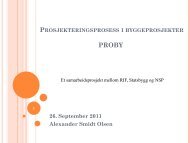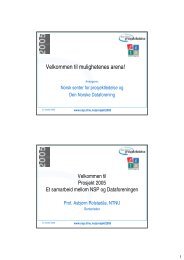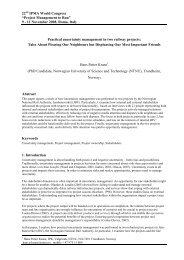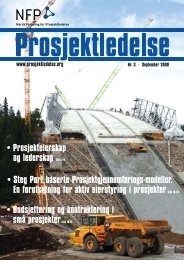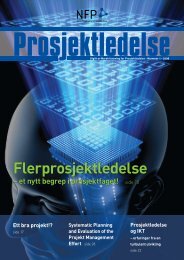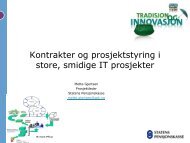Nr. 2-2004 omslag - Norsk senter for prosjektledelse - NTNU
Nr. 2-2004 omslag - Norsk senter for prosjektledelse - NTNU
Nr. 2-2004 omslag - Norsk senter for prosjektledelse - NTNU
- No tags were found...
Create successful ePaper yourself
Turn your PDF publications into a flip-book with our unique Google optimized e-Paper software.
Closeout SupportThe closing phase of any project typicallyis the least exciting. The actualproject work has been done at thistime, and the project team members areanxious to move on to new challenges.It is easy and tempting not to completethe remaining administrative requirements.The PMO can provide staff toassist in the closing process. It can preparea checklist of items that must bedone and can provide a closeout managerto ensure completion of the projectwork.Enterprise-Oriented FunctionsIf the PMO is established at the enterpriselevel, it is the focal point <strong>for</strong> projectmanagement improvement andenhancement by establishing best practicesin project management and providingtraining to staff at all levels of theorganization. The PMO staff membersserve as an advocate <strong>for</strong> the projectmanagement culture by showing thetangible benefits of project managementto the corporate strategy. Easy-to-useand accurate models and procedures <strong>for</strong>estimates and schedules can be provided.The PMO can set up standardmethodologies and repositories <strong>for</strong> lessonslearned. Quantitative objectives<strong>for</strong> improving project management processescan be set up to support continuousimprovement initiatives. Best practicescan be integrated and disseminatedinto enterprise project managementpolicies. Each project then can be consideredas an opportunity <strong>for</strong> learning.The PMO further can develop and presenttraining programs on all aspects ofproject management.One of the most visible functions is todevelop, record, compile, and disseminatethe best practices in project management.This repository of in<strong>for</strong>mationwill be continuously evolving. ThePMO will maintain project archivescontaining data on project life-cycleper<strong>for</strong>mance and project scope, cost,schedule, and risks. With PMO involvementthe data and their analysis canbe placed in a <strong>for</strong>m that is accessible,reliable, and readily usable by futureprojects. Since it is not sufficient tocollect project data and then file itaway, guidelines and a standard repositoryare required. In order to makedata retrieval user friendly, the PMOFacilitate Communication andCustomer SatisfactionCommunication is critical <strong>for</strong> effectiveproject management. To promote organizationalchange across organizationalboundaries, the PMO can facilitatecommunication on project managementby keeping up with the latest developmentsin the field and with implementingthe latest best practices.Additionally, the PMO staff memberscan <strong>for</strong>mally measure and track customersatisfaction on projects <strong>for</strong> thebenefit of the organization and to supstaffcan cross-reference the repository.It focuses on integrating positive projectpractices, promoting the use of recommendedtools and templates, and providingguidance and support.Other areas of enterprise-oriented tasksinclude the following.EstimatingWhen project estimating is per<strong>for</strong>medby staff in the enterprise PMO, company-specificproductivity history, learningcurves, and appropriate experiencecurves can be applied to recurringtasks. The PMO can develop company-specificlife-cycle cost and schedulemodels and an approach so that thosedeveloping estimates and scheduleshave access to a vast array of enterprisedata. The PMO also can maintain aportfolio of customized estimatingmodels <strong>for</strong> developing estimates at differentpoints in the project life cycle.SelectionProjects link enterprise strategy to tangibleresults. Since there are notenough resources or assets to invest inevery project, those projects that bestsupport the organization’s vision, mission,and goals must be selected. Thus, astandardized process of project selectionwith common criteria is required.The PMO staff, serving as a neutralobjective <strong>for</strong>um, can best develop thesecriteria and this process. The PMOstaff also can support executives byproviding in<strong>for</strong>mation <strong>for</strong> use in decisionmaking, both in selecting projectsand later in reprioritizing them, by preparinga high-level assessment of theproject’s tangible and intangible benefitsand any affected functional areas.This can lead to development of possiblealternative courses of action toconsider.Data IntegrationMost organizations have a number ofprojects under way at the same time,but their project management in<strong>for</strong>mationsystems only provide visibility atthe individual project level. Manytimes multiple project planning andreporting procedures are unwieldy andare difficult to use. Managementreports may not be meaningful. ThePMO can provide a leadership role indata integration to standardize projectper<strong>for</strong>mance reports so that uni<strong>for</strong>mdata are collected <strong>for</strong> every project.This can include a multi-project resourceutilization environment with an integratedmanagement policy. Data integrationmust use a common projectmanagement system <strong>for</strong> all projects.Such consistency is achieved by usingthe same software system, data procedures,and data reporting processes oneach project implemented in the organization.Reward and RecognitionTraditionally, individuals are rewardedbased on their personal contributionsrather than on the contributions of aproject team. Often these pay-<strong>for</strong>-per<strong>for</strong>mancesystems tend to foster competitionamong team members when workingon a project. To highlight theimportance of project work to the organization,the PMO can develop a teambasedreward and recognition system.This can be accompanied by developmentof a 360-degree or multi-raterevaluation process with factors that canbe tailored <strong>for</strong> the unique requirementsof each project team. These approachescan help foster cooperation andcollaboration.Project AuditsThe PMO at the enterprise level willhave appropriate resources to conductregular and frequent audits. The purposeof the audit is to collect data onthe various facets of the per<strong>for</strong>mance ofongoing projects. Project audits canprovide an impartial, objective appraisalof projects to establish their truestatus. They can identify best practicesto be transferred to other projects andfailed strategies to be avoided in futureprojects.18Prosjektledelse <strong>Nr</strong> 2-<strong>2004</strong>



